top of page
middle east
Jews of western and central Asia are often grouped with Sepharadim, and to some extent were influenced by them.
Jews in Central Asian countries are called Eidot Hamizrach. Included are Iraq, Iran, Afghanistan, Kurdistan, even India. (There were virtually no Jews in Jordan or Arabia after the Moslem conquest.) Sometimes the term is applied inaccurately to all non-Ashkenazic Jewry. These communities had ancient traditions not related to Spain, but were inevitably influenced by them. Now, they are often grouped together with Sepharadim and in Israel are under the leadership of the Sephardic chief rabbi. Today they are oftenn grouped together with Sepharadim, and in Israel are under the leadership of the Sephardic chief rabbi.
 Middle East map | 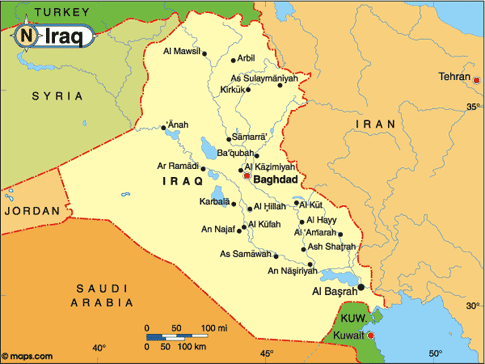 Iraq.mapAncient Babylonia's Jews arrived around the destruction of the 1st Temple. Later rabbinic exiles founded Talmudic academies there. The stability of early Moslem rule promoted a flourishing Jewish life. Imposition of the 'Pact of Omar rules reduced many freedoms. Under the Ottomans Jews were prominent in commerce & politics but after independence in 1932 antisemitism flourished. Jews left by 1951 in 'Operation Ezra & Nechemia', giving up their wealth. 125,000 in 1947, virtually none remain. |  Iraq.synagogue.Shaf VeYativThis synagogue in Baghdad is called the 'Great Synagogue' while the Jews called it 'Shaf VeYativ'. Local tradition says it is an ancient synagogue site dating back to the first Jewish exiles. The current building is a reconstruction that has been made into a museum. It is described as built 'in the Persian style'. |
|---|---|---|
 Iraq.synagogue.Meir EliasMeir Eliyahu Shlomo David (ca. 1855-1910) founded the Meir Elias hospital. After his death, his house in Baghdad was converted into the Meir Elias synagogue. We see familiar prayers and charts on the walls. 7 Sifrei Torah are displayed in front of the Aron Hakodesh, all housed in canisters (Tik) with the 2 Rimonim on top. They open in the center and stand up vertically on a table for the Hazan to read. | 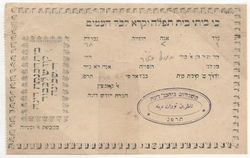 Iraq.synagogue.receiptThe 'Dinah' synagogue was one of 60 in Baghdad. This receipt for a donation says 'Received from Shaul Katir 9 annas in Baghdad 19 Adar 5683 (1923)' and bears the synagogue seal. The Hebrew letters form Judeo-Arabic words, still in use then. Annas are a type of money usually associated with India, but the British also ruled Iraq at this time and used the same system here. |  Iraq.greetings.scenesThis card bears several Sephardic holiday greetings including: Tizku Leshanim Rabot = May you merit a long life, and Moadim Lesimcha =Joyous Holidays ( a quote from the kiddush). Pictured are 4 Jewish sites: the grave of the prophet Yechezkiel, the grave of Ezra the Scribe, the grave of Yehoshua Kohen Gadol, and the synagogue named for Albert Sassoon. At the bottom we read 'Blessings from Aram Naharayim' the biblical name for Mesopotamia. |
 Iraq.rabbiThis man is Haham (rabbi) Moshe Shelomo Shamash. The caption identifies him in Arabic. He is wearing the classic clothing of a chief rabbi in the Ottoman Empire, complete with the seven-pointed badge on his robe. | 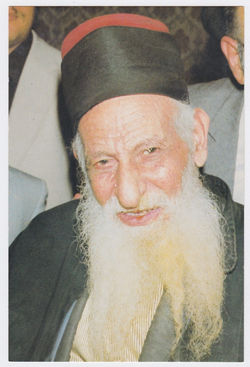 Iraq.Rabbi KadouriR' Yitzchak Kadouri was born in Iraq in about 1902 and moved to Palestine in 1923. He lived well over 100 years. He was a devout scholar, Kabbalist and 'Holy man'. His manner and clothing are reminiscent of his birthplace. |  Kadouri.AmuletIn particular, R' Kadouri was known and sought after for his amulets, which were reputed to help with a variety of human needs. This one shows his image, wearing a fez, with mystical words around. His name is at the bottom. |
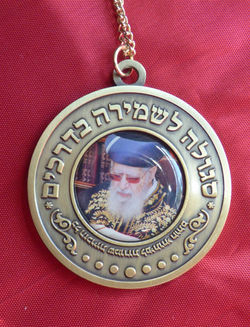 Sepharadi.Kamea.Ovadya Yosef.frontThis charm or amulet pictures R' Ovadya Yosef (1920 - 2013). He was born in Iraq but his family soon emigrated to Jerusalem. His Torah genius was recognized early and he was ordained at 20. He became a major spokeperson for the Eidot Hamizrach community . Elected chief Sephardic rabbi in 1973. R' Yosef was famous for his photographic memory of religious texts. |  Sepharadi.Kamea.Ovadya Yosef.backThis side of the medalet reproduces a letter of blessing from Rav Yosef, wishing long life, happiness and honor to the recipient. |  Iraq.rabbinic courtThree judges of the Baghdad beit din wrote this to testify to the marriage and Ketubah of Zalah Yosef and his bride Katoon bat Yaakov Shemuel on the 8th of Kislev 1891. It lists all the dowry promises and their value. The date of THIS document is 18 Kislev 1923 ! Perhaps the original Ketubah was lost and this was written to replace it - as the halacha requires. Signed Yechezkel Ezra Eliyahu, Rephael Yitzchak Hayyim and ? |
 Iraq.siddurPrinted in Baghdad in 5705 = 1945. Includes prayers for Mincha and Ma'ariv including Friday night. All directions are in Hebrew. Like many Sephardic prayer books, it opens with a 'Shiviti', a chart of Hebrew phrases and Kabbalistic formulas. 'Shiviti (Hashem Lenegdi Tamid') means I see G-d before me always. It reminds us to have Kavana - concentration and focus in our prayer. | 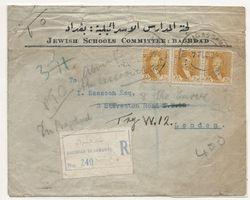 Iraq.schoolIraq had private and public religious schools and 2 Yeshivot. The Alliance set up 15 schools starting in 1864. Their schools emphasized western languages and secular subjects. This committee supervised all. But a diploma from a government school was a ticket to a good job or to entrance to university which also meant exemption from military service. Mailed registered to London in 1939. |  Iraq.school.Alliance.letterheadThe committee's letter is addressed to I. Sassoon, a member of the wealthy and influential Iraqi family that relocated to London. They operate a Jewish college named for an ancestor Albert Sassoon. |
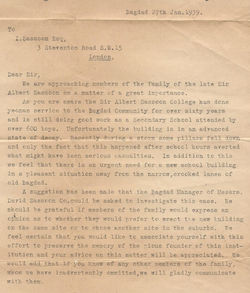 Iraq.school.Alliance.messageScan0096The message reports that the school building is in serious disrepair. They would like to enlist support for building a new one and felt sure that the family, Albert's descendants, would wish to contribute. |  Iraq.Sofer.Yechezkel Yosef Sehayik is a sofer in Baghdad. Writing on his own stationery, he addresses the 'most lofty and honorable grand rabbi of Tel Aviv - Yafo' who in 1935 was R' BenZion Meir Hai Uziel. 'I sent you a sample of the Torah I'm writing, for which the price is 43 pounds. You replied that ... you wish to pay only 25. I am willing to give up all my profit in the hope of future business and charge only 29 pounds. The sefer is almost half written already...'. Written in soletreo. |  Iraq.Jewish woman'Israelite of Baghdad'. Mailed from India, where many Iraqi Jews lived, to Belgium. Women were still wearing traditional clothing in 1909, but changes were beginning. First came imported fabrics in traditional styles, then a gradual adoption of European features. This woman is wearing leggings, a wide skirt, and a trimmed velvet jacket. Her elaborate headdress suggests she is a young married woman. |
 Iraq.Jewish homesThis stereo view card photo caption reads 'Picturesque homes of wealthy Jews along the Tigris (river) in North Baghdad Irak'. Not opulence but location and shade trees made them desirable. The heat could reach 120 degrees. People often slept on the flat roofs to catch the cool air. Stereo cards were a popular way to see 3D images of exotic places, in a special viewer held up to the eyes. |  Iraq.overland mailAbraham Haim, one of the many well-to-do merchants in Iraq, sent this letter in 1926 by the Overland Mail Route from Baghdad to Haifa. A trip that took 2 months by camel, this British service now took 24 hours. Sometimes passengers also went along, in 18 wheel air-conditioned coaches. The service stopped in 1933 as air mail developed. |  Iraq.Overland mail.mapWhen the mail reached the port city of Haifa, it was forwarded to Europe, in this case, Switzerland. Postage was attached to the back of the envelope. |
 Iraq.merchant.Judeo-PersianMailed from Baghdad to Jerusalem in 1937. Aharon Yakov Yosef Knisai is looking to do business. At the bottom of the letter are recommendations of friends. The writing is Judeo-Persian. It looks like Hebrew until you try to read it. Still in use in 1937, it is dying out today. | 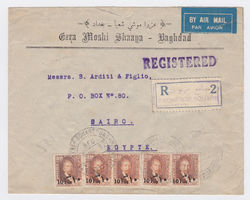 Iraq.merchant coverEzra Moshi Shaya is a merchant in Baghdad. He sent this envelope registered mail in May 1932 to Cairo Egypt. There is no Hebrew but his names are very Jewish, all from the Torah. |  Iraq.stamp dealerMorris Abraham was a Jewish stamp dealer in Baghdad. He sent out cards like this to increase business. This one went to a dealer in Wisconsin, postmarked 11 March 1946. The unrest in Palestine and the Nazi attitudes of WWII caused a deterioration in Jewish life. Things got much worse after 1948. this card was sent just months before those events. |
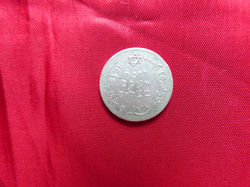 Iraq medal HebrewA personal medal of one Yosef Yaakov Matzliach. On this side, we see his name in Hebrew, and apparently his birth date, in 1878. |  Iraq medal arabicThis side of the medal is all in Arabic, where he proudly describes himself as 'Head of property of Jews of Palestine' It is dated 1930. Perhaps he was responsible for collecting charity donations for the Holy Land. | 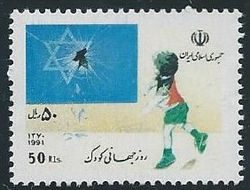 Iraq.anti-ZionistA government-issued stamp in 1991 pictures a boy throwing a rock through a window. The window bears a six-pointed star, signifying Jews. The boy's clothes are colored black, white, red, and green - flag colors of Palestinian and other Arab groups. Under Moslem law, a child could throw stones at Jews without being punished. How chilling to live in this atmosphere. The image also reminds one of Krystalnacht in Germany. |
 Iraq.Zionist fundraisingRabbi Aaron Sasson writes to R' Aaron Mendel Cohen of the Ashkenazi community of Cairo in 5619 (=1919) to hear news of the Jewish world and about a shipment of 'Shekalim', referring to the receipts picturing an ancient shekel that were given to members of the World Zionist Organization. He writes in lovely clear Sephardic script, which has some elements of soletreo, like the mem, lamed, and hey, and some elements of 'Rashi' style like the alef and Tav. | 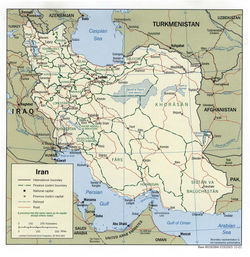 Iran.map | 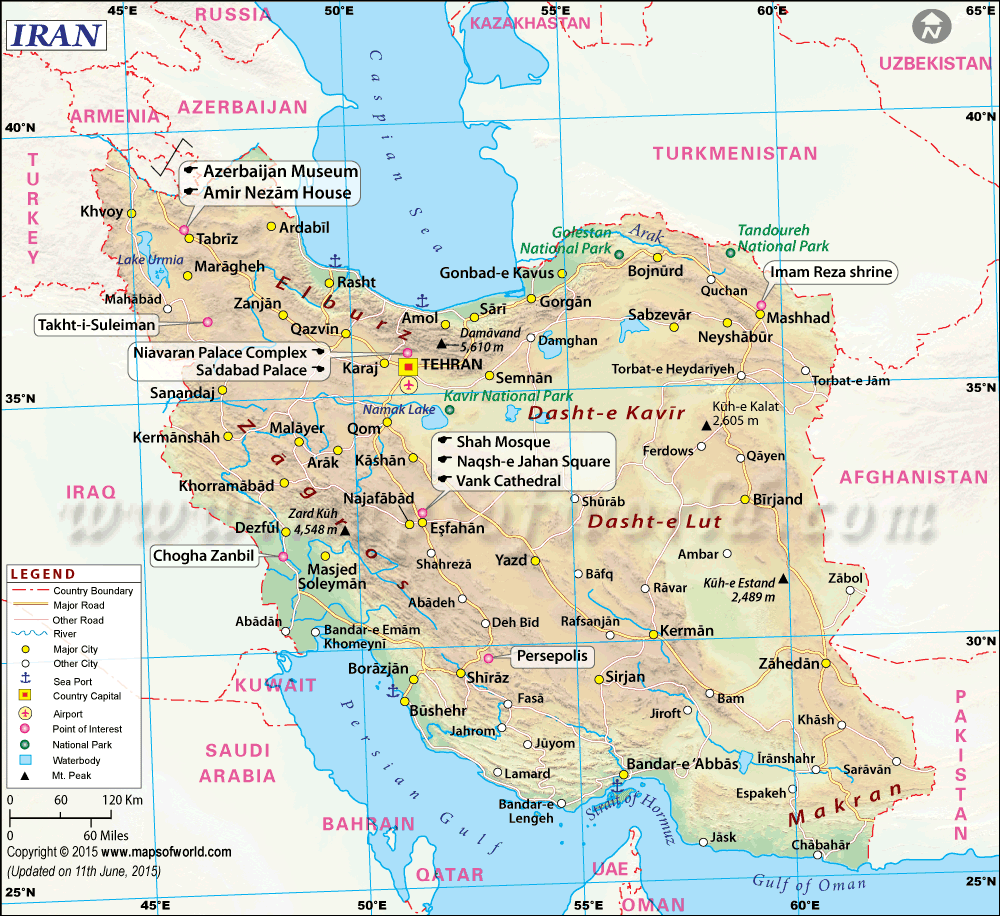 Iran-mapJews were brought to Persia after the Assyrian & Babylonian conquest of Israel. 1000 years later, Moslem conquest made them 2nd class citizens. They were craftsmen, merchants, & later bankers. Forced conversions & famine confronted them in the 1800's. The Pahlevi dynasty (1925-79) brought westernization & secularization to the country, and freedom for Jews The Islamic revolution of 1979 imposed religious law & revived discrimination. Most of the 80,000 Jews emigrated. About 20,000 remain. |
 Synagogue.IsfahanIsfahan is one of Iran's 3 main Jewish communities. It's in the country's third largest city; the main synagogue on Palestine Square holds public prayers several times a day. This 8x15 foot wall comes from Isfahan and is today displayed in New York's Jewish museum. The verse is from Psalms 118. The niches hold 3 torah scrolls in their round silver 'Tik' containers. Origianally 16th century. |  Iran.synagogue.receiptThis is a receipt for a donation to a synagogue in Shemiran, a suburb of Tehran. It is the Darvazeh Dolat synagogue. Shemiran is a high class multi-ethnic suburb. The receipt reads in Hebrew: When you make a pledge to the Lord your G-d don't delay paying it, a quote from Deuteronomy 23:22. Other words in Hebrew letters are Persian. The rubber stamps reads in Hebrew: Synagogue and Kindergarten. |  Iran.rabbinic envelopeThis envelope bears the printed name and titles of Ezrah Rabbi Joseph Nouriel, Kohen Tzedek, in Hebrew and in Persian. Inside is a business letter recording merchandise and the profit made from it. It is addressed to several businessmen and wishes them long life. It was sent from Shiraz to Isfahan in the mid 1920s. |
 Iran.rabbinic mailRabbi Ovadia Yosef was chief rabbi of Tel Aviv in 1971 when he wrote to Rabbi Uriel Davidi in Tehran. The topic is the building of new mikvaot and R' Yosef wanted to be kept up to date on their progress. There were still over 50,000 Jews in Iran in 1971 but most left the country after the revolution of 1979. |  Iran.Torah manuscriptThis leaf is from a book about biblical Deuteronomy. The first 2 words are from the beginning. It is written in Hebrew letters but Judeo-Persian language. Here and there Hebrew phrases can be seen. Persia is famous for its miniature illuminated art. They were commissioned by wealthy patrons to illustrate books, Jewish included. It is over 100 years old but the gold and other colors are still bright and attractive. | 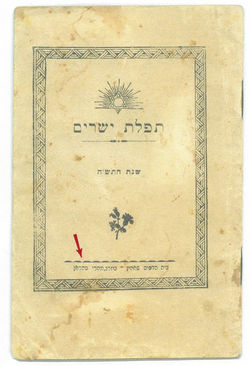 Iran.Hebrew and Aramaic prayersTefilat Yesharim is a booklet of special prayers said at weddings, funerals and other occasions. It includes 'Patach Eliyahu' which is said during the year of mourning but also daily before Shacharit. Kaddish is included. As the cover shows, it was printed in 5705 = 1945 in Tehran. |
 Iran.Passover HaggadahThis Passover Haggada was published in Iran in 1962. On the cover it is dated 'Adar 5722' and also has the Moslem date 1345. You can see the Persian translation, in Arabic letters, after each paragraph. |  Iran.Torah credentialsA handwritten recommendation / diploma for R' Yaakov ben haRav Shemuel haLevi. He has studied Gemara and Poskim for 4 years in the Yeshiva and now wishes to teach young students. Dated Elul 5671 (1911) at 'Shushan Habirah which is called Hamadan', it is stamped with the seal of the chief rabbi, in Hebrew and Persian. Actually scholars don't think Hamadan in western Iran is Shushan but it is a tradition among Persian Jews. Hand lettered in mostly Rashi style letters on rough textured paper. |  Iran.Jewish familyWritten in Persian and mailed from Meshad to Constantinople Turkey in 1914. The caption tells us these are Jews from Salmas, a region in NW Iran called Azerbaijan. They speak Aramaic or a dialect of Persian called Tat. Their dress is distinctive. The men often show fur hats and the women are covering their faces reminiscent of Moslems. They are referred to as mountain Jews. |
 Baku.KetubaThe Mountain Jews in Baku, Azerbaijan date back to the 7th century. Ashkenazi Jews arrived in the 1800s and became a majority. Baku was oil-rich country and the Rothschilds established their company there. It became a center of Zionism. This Baku ketuba dated 5678/1918 notes marriage between Yakov Wolf and Tzilia Halevy, apparently Ashkenazim. Kurdish and Georgian Jews also settled here. |  Baku.Kesuba.RussianThe back of the Ketubah shows this Cyrillic text, presumably the equivalent. the spaces are not filled in. |  Iran.Jewish doctorThe caption reads 'Jewish Doctor'. He looks wise doesn't he? Jews gained prominence in the Arab world as physicians. Strict Moslem law discouraged Jews from treating Moslems but this was overlooked, especially by ailing Sultans and Caliphs. Famous Sephardic physicians include Hasdai ibn Shaprut, Yehudah Halevi and the great Moshe ben Maimon, the Rambam. Mailed to Belgium 1913. |
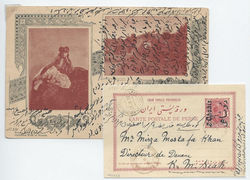 Iran.Jewish woman"Jewish Woman in Sennah' a city in Western Iran. Jews lived here, in harmony with Moslem neighbors since the 1400's. About 250 families lived here in the 1800s. The woman is dressed in traditional clothing, including headdress. Usual for her location but exotic looking to Europeans. The other photo, unclear, seems to show a monument or bridge. |  Iran.JewessThis postcard is from a series of ethnic Jewish costumes, photographed in Israel. The caption on the back reads 'A Veiled Girl From Persia'. |  Iran.Modern clothingWhen Reza Kahn became Shah (king) in 1925, he pushed Iran into the 20th century. Reducing the power of clergy, he made the country more secular and thus more tolerant for Jews, who in turn participated more freely in society. He abolished the turban and the veil, introducing European clothing. This couple is relatively modern - for the early 20th century. A beautiful Persian carpet forms the backdrop for their photo. |
 Iran.medal to ShahReza Kahn was forced to abdicate in 1941 but his son Mohammad Reza Shah succeeded him. There was even more political freedom. Jewish newspapers, the Jewish Agency, and the Joint Distribution Committee functioned freely. In 1966 the 'Council of the Jewish Community' struck a medal honoring the Shah's 25th year, in gold, silver, and bronze. Shah on the front, menorah on the back, 'Rosh Hashana 5726'. The revolution of 1979 ended all that. |  Iran.MerchantThis is the business envelope of Joseph Hezkia who is a jeweler ('Djevaheri'). He is comfortable putting not only his Hebrew name on the envelope but also a six pointed star with Hebrew letters in the angles and the word ZION in Hebrew in the middle. He writes to another Jewish businessman, Mr. Zachariah Asher Gathan and Son in Tehran. | 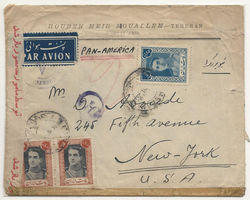 Iran.businessUnder the Pahlevi Monarchy (1925 - 1979) Jews flourished economically. They controlled the textile import trade and became factory owners and industrialists. This envelope was sent by businessman Reuben Meir Mouallem in Tehran, censored by the Persians (1945) and reached New York City. The stamp pictures the young shah, who had taken over from his father in 1941. |
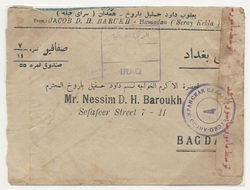 Iran.family businessMailed from Hamadan to Baghdad, Iraq. Sender and receiver have the same last name. Perhaps these were 2 branches of a family business. The censor mark reads 'Anglo-Soviet-Persian'censorship'. This was 1942 and Britain and Russia were suspicious of Iran's ties to Germany so they invaded the country and controlled the government. They left Iran after the war. |  Iran.international financeA promissory note transferring money from Tehran to Istanbul, Turkey. It is dated 17 Adar (5)671 = 1911. The transfer is on behalf of Yitzchak Mordechai who signed in Hebrew and also stamped his Hebrew/Persian seal on it. Interesting combination of Persian pre-printed script and Judeo-Persian insertions in Hebrew letters. Obviously, parties on both sides of the transaction could read and understand the writing. |  Iran.international finance.detailClose up we see Hebrew signatures in Judeo-Persian script. Also the negative seal of Yizchak Mordechai in Hebrew and Persian. And a rubber-stamped impression that reads 'paid' in Judeo-Perisan and in French. |
 Iran.Judeo-Persian mailThese pieces of mail from Iran in the early 1900s are addressed in Persian but also have Judeo-Persian messages and comments, in Hebrew alphabet, right on the front. One mentions Rabbi Shimon'. Such an obvious display of Jewish culture was much more tolerated then in Iran than it is today. |  Iran.Judeo-Persian mail.2An invitation written right on the envelope! 'To Who it May Concern - You are cordially invited for the gathering and dinner party of the mother of the late clergyman Motere. We will be honored to have you.' The address is in Persian while the message is in Judeo-Persian Hebrew letters. 1928. |  Iran.mail.hand deliveredA letter written in Judeo-Persian in the 1920s. Personal message regarding family and health matters. The date on top appears to be Hebrew: Saturday night, 4 Adar I, 568?. Signed at the bottom Yosef S'T' (Pure Sefaradi). It does not bear any stamp or postmark so must have been delivered by hand. |
 Iran.mail.negative sealThe envelope is sealed with the personal seal of the writer, with Hebrew Persian and Latin letters. 'The young R' Yosef son of the Honorable Rabbi & Judge my teacher my father Baba'. Persian seals are engraved on semi-precious stones, stamped in ink and pressed onto paper. The uncarved areas come out black from ink and the carved areas remain white. This is called a negative seal. | 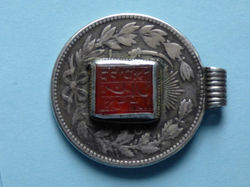 Iran.seal on coinHere is an Iranian Jewish seal. It has been carved into semi-precious stone. Then it was mounted on a dollar-size silver coin. A wide ring was soldered on the edge so that this item could be worn around the neck. |  Iran.seal impressionThe carving is in Hebrew and Persian. The top word clearly says Suleman in Hebrew letters. The bottom Hebrew letters are Alef Lamed Reish and seem to be an abbreviation. The carving is very clear and precise. |
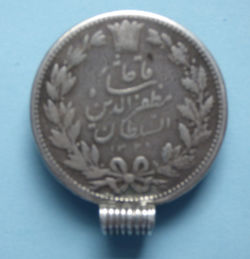 Iran.seal coin.backThe host coin is a silver 5000 dinar coin dated 1320 AH = 1902. At that time the ruler was Mozafar Ad Din Shah, who ruled from 1896 to 1907. |  Iran.mail to Palestine JewFrom a Jew in Iran to a Jew in Haifa Palestine. The sender worked for the Anglo Iranian Oil Company (which later became BP). From Iran to Baghdad and Basra in Iraq to Palestine. Censored in Iraq and 'written in Hebrew'. You wouldn't likely see such a letter in the mail today. |  Iran.mail.Palestine.backA. Ben David writes in Hebrew to Palestine. His return address is Abadan Iran.There an oil refinery was completed in 1912 which became the largest in the world. It was a British undertaking but eventually all such properties were nationalized by Iran. The AIOC became known as British Petroleum, BP. |
 Iran.Teheran childrenThousands of Polish refugees fled to the Soviet Union after German attacked Poland including many Jews and hundreds of orphans. These were later shipped to Tehran. In early 1943 they were permitted to make the long Journey to Palestine. Henrietta Szold head of Youth Aliyah was instrumental in saving and relocating these children. Rabbis Amiel and Prato, Tel Aviv leaders, are respectfully asking for at least 30 children to be placed in their religious school network. |  Iran.Joint committeeThe American Joint Distribution Committee worked to provide rescue and relief in many theaters of crisis during WWII. Their office in Tehran was able to provide relief to thousands of Polish Jewish refugees who had reached Poland. This card was mailed by such a refugee Yosef Dolinsky in 1945 from Bukhara to the Joint office in Tehran. Anglo-Soviet-British censorship is evident. | 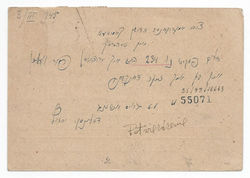 Iran.Joint.messageDolinsky writes to the Joint office: 'The packet # 234 I received for which I am grateful to you.' Dated 8 March 1945. The Joint, the Jewish Agency, and other organizations operated freely in Iran at this time, to help Jews in need. |
 Iran.Tehran.JNFThis receipt was issued by the Jewish National Fund, known in Hebrew as Keren Kayeket LeYisrael. The heading reads 'National Council of Iran'. It was issued in Tehran in 1944. |  Iran.Zionist youthZionist activity was tolerated under the Pahlavis and the country had a good relationship with Israel, although they had voted against it in the U.N. and received criticism from other Moslem countries. Younger Jews began to learn modern Hebrew in the 60's and many eventually emigrated there. This calendar was sent out in Iran in 1963. |  Iran.Zionist youth calendarThis calendar was sent to a member of the Zionist youth group 'Dror'. It includes New Year greetings for the Jewish year 5724 = 1963-64. It offers wishes for 'Pioneering Achievement'. |
 Afghanistan.kamea.square.engraved.frontThis is a silver amulet from Afghanistan. It was made by a Jewish silversmith and was worn by Jews. It is intended to hang from the neck. The boxlike shape was hollow, providing room for a good luck and protective formula to be written and inserted inside. This style seems to be borrowed from the majority Moslem culture, although amulets themselves have been around since antiquity and are mentioned by the rabbis. |  Afghanistan.kamea.square.engravedThis amulet has been skillfully engraved on the back in Hebrew. "A person will find power in his treasure and can attain the pleasures of the moment ...money is the answer to many things." |  Afghanistan.silversmithThis photo shows an Jewish Afghani silversmith at work. It may have been taken in Israel. It shows him wearing 20th century clothes, but working in an ancient posture and style. The Jewish community was cut of from modernization until they emigrated. |
 Afghanistan.kamea.engraved coinThis simple charm was made from an Afghani coin of the 1950's. The simple addition of rings turns it into a necklace, with place to hang ornaments. Simple glass jewels add a nice touch. Interestingly, it has been hand engraved over in Hebrew: May G-d shine his face upon you יאר פניו אליך which is part of the priestly blessing. |  Sepharadi.Afghanistan.engraved coin.backThis is the back of the Afghani coin charm. | 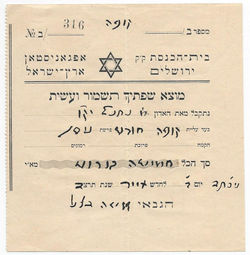 Afghanistan.receipt.scriptA receipt for donating to the Afghani Synagogue in Jerusalem. It is for the amount of 5 Grush (Palestine mils) and is dated Iyyar 5692 = 1932. Jews emigrated to Israel and elsewhere in the first half of the 20th century and the rest in the 50's & 60's. None remain in Afghanistan. |
 Bukhara.Rebbe and students 001 (2)The Bukharan (today Uzbekistan) Jewish community dates back to antiquity. Culturally close to Iran. Suffered Moslem persecution. The Soviets weren't much better. Most have emigrated to Israel or USA. Here is an early modern photo of Jewish children in Bukhara, under the tutelage of their Rebbe. They are sharing 3 Torah books. |  Azerbaidjan.Baku.KesubaToday, the 16,000 Jews in Azerbaijan mainly consist of three distinct groups: Mountain Jews, the most sizable and most ancient group; Ashkenazi Jews, who settled in the area during the late 19th-early 20th centuries, and during World War II; and Georgian Jews who settled mainly in Baku during the early part of the 20th century. This Kesuba contains the typical Ashkenazic text, and names that are likely Ashkenazic. the country has friendly relations with Israel. |  Baku.Kesuba.RussianOn the back is a version in Russian. Presumably it is a translation |
bottom of page